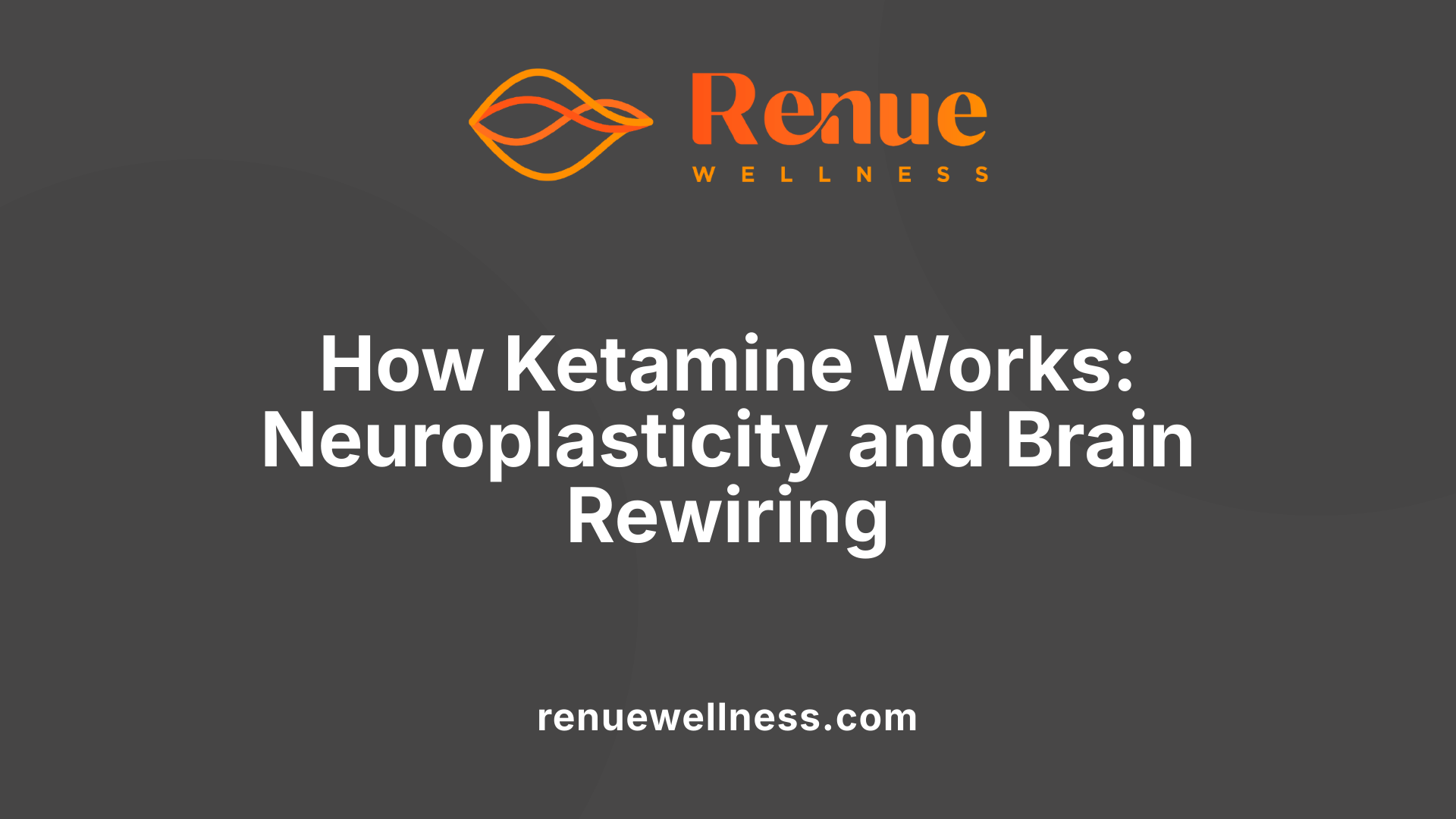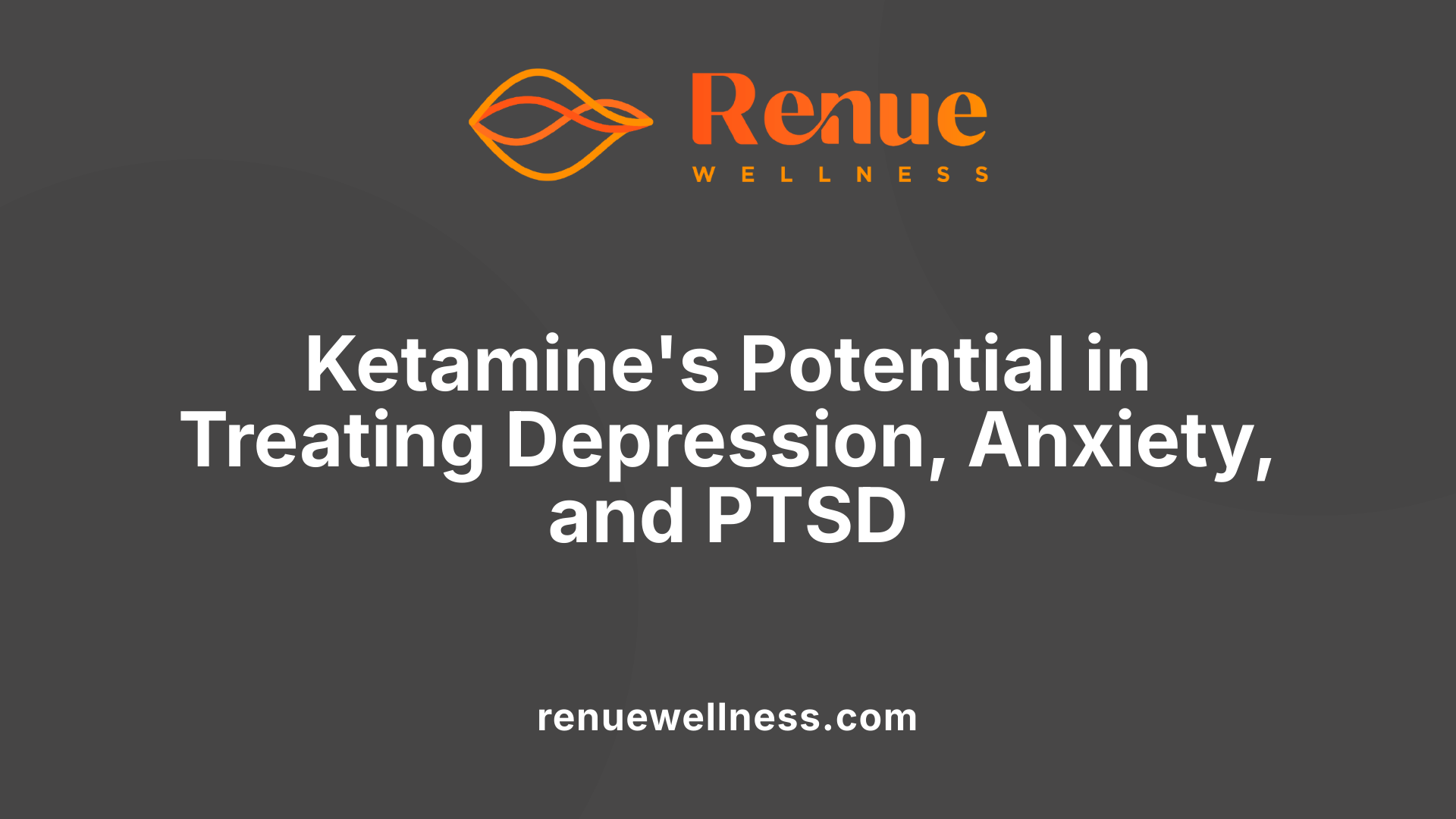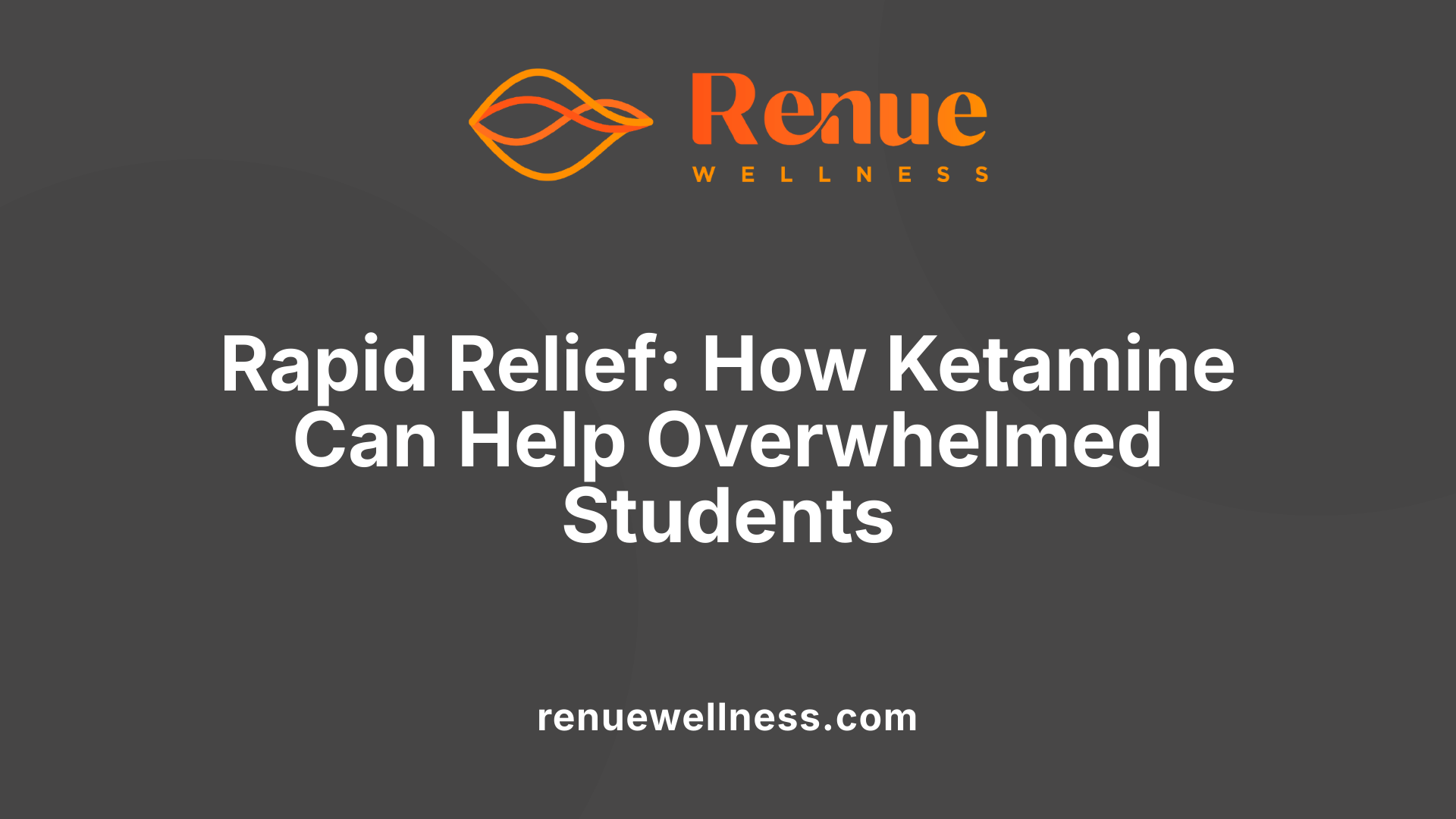Can Ketamine Help College Students Struggling With Burnout?


August 5, 2025
Understanding Burnout and Emerging Treatments in Higher Education
College students frequently experience burnout due to academic pressure, social challenges, and personal stressors. Traditional interventions, including counseling and stress management, are often effective but may not fully address severe or treatment-resistant cases. Recent research highlights ketamine therapy as a promising alternative for mental health conditions linked to burnout, offering rapid symptom relief and neurobiological benefits.
The Nature of Burnout in College Students

What is burnout and what are its symptoms?
Burnout is a state of emotional, physical, and mental exhaustion caused by prolonged and excessive stress. It manifests through symptoms such as fatigue, decreased motivation, difficulty concentrating, irritability, and feelings of helplessness. For college students, burnout often results from academic pressures, social challenges, and balancing multiple responsibilities.
How does burnout affect academic performance and mental health?
When students experience burnout, their academic performance can decline due to lack of focus and energy. It also impacts mental health, increasing risks of depression, anxiety, and feelings of isolation. Burnout can make students withdraw from social activities and hinder their overall well-being.
Why is burnout becoming more common in higher education?
The rising levels of academic competition, digital distractions, and the COVID-19 pandemic have contributed to the growing concern over student burnout. Many students face chronic stress without sufficient support, leading to a surge in mental health issues.
Can ketamine help alleviate burnout symptoms in college students?
Research on ketamine's direct use for burnout in students is limited. Currently, there's no conclusive evidence that ketamine effectively treats burnout specifically. However, studies show ketamine's rapid antidepressant effects and success in reducing depression and anxiety, conditions often linked to burnout.
Ketamine works by targeting the brain's glutamate system, increasing neural plasticity and fostering new connections. This mechanism helps improve mood and reduce feelings of hopelessness. For individuals struggling with emotional exhaustion and mental health symptoms, ketamine’s ability to promote neural growth may offer some relief.
Caution and alternatives
Despite these promising findings for related conditions, using ketamine for student burnout should be approached with caution. It requires medical supervision and is not yet approved specifically for burnout treatment in college populations.
Traditional approaches, such as counseling, stress management strategies, and self-care, remain the primary recommendations. More research is needed to establish the safety and effectiveness of ketamine for burnout in students.
| Treatment Method | Effectiveness | Notes |
|---|---|---|
| Ketamine Infusions | Rapid mood improvement; less studied in students | Requires medical supervision; more research needed |
| Counseling & Therapy | Proven benefits for stress and mental health | Widely accessible; focuses on emotional resilience |
| Stress Management & Self-care | Supports overall well-being | Effective when consistently practiced |
While ketamine shows promise for mental health conditions similar to burnout, integrated approaches remain foundational. Experts recommend prioritizing proven methods until more specific research becomes available.
Ketamine’s Neurobiological Mechanisms and Therapeutic Action

How does ketamine act on NMDA receptors?
Ketamine primarily functions as an NMDA receptor antagonist in the brain. These receptors are part of the glutamate system, which is crucial for neural communication and plasticity. By blocking NMDA receptors, ketamine prevents excessive glutamate activity, which is often linked to stress and neurotoxicity. This action leads to an increase in glutamate levels through a process called disinhibition, promoting rapid neural activity shifts.
How does ketamine promote neural plasticity and growth via BDNF?
One of the remarkable effects of ketamine is its ability to boost levels of brain-derived neurotrophic factor (BDNF). BDNF is a protein that supports the survival, growth, and differentiation of neurons. Elevated BDNF levels foster synaptic connectivity and neural rewiring, essential for recovery from mood and anxiety disorders. This neuroplasticity mechanism underpins ketamine's rapid therapeutic effects, enabling the brain to reorganize itself and form new, healthier connections.
What role do anti-inflammatory properties play in ketamine’s effects?
Chronic stress and depression are often associated with brain inflammation. Ketamine has anti-inflammatory properties that may help mitigate this inflammation, leading to symptom relief. By reducing neuroinflammation, ketamine helps restore normal brain function and improves mood. These properties add another layer to its therapeutic profile, especially relevant for individuals experiencing burnout where inflammation may contribute to their symptoms.
How effective are ketamine treatments for mental health conditions related to burnout, such as depression, anxiety, and trauma?
Ketamine offers significant hope for people suffering from burnout-related conditions, including depression, anxiety, and trauma. Many patients experience rapid symptom improvements, sometimes within hours or days of the first treatment. Clinical data shows that over 70% of patients with treatment-resistant depression and PTSD report substantial symptom reduction after a series of infusions.
Studies indicate that about 65% of patients see their symptoms improve by more than half, with effects often lasting for weeks or longer. These benefits are supported by the drug’s ability to reconnect brain circuits and promote neural growth, addressing the root causes rather than just alleviating symptoms temporarily.
In practice, ketamine is administered in a controlled environment by healthcare professionals to maximize safety and effectiveness. While some side effects such as dissociation, nausea, and temporary increases in blood pressure can occur, careful monitoring helps mitigate risks.
Overall, ketamine's quick onset and sustained benefits position it as a promising treatment for burnout, especially when traditional therapies have failed. Ongoing research continues to refine its protocols and expand understanding of its full potential for mental health care.
Efficacy of Ketamine in Treating Severe Mental Illnesses

Does research support the use of ketamine for mental health challenges associated with burnout in college students?
Emerging evidence indicates that ketamine offers a promising approach for addressing severe mental health issues linked to burnout, such as depression, anxiety, and post-traumatic stress disorder (PTSD). Clinical trials and case reports have demonstrated rapid symptom relief, often within hours to days after treatment.
For example, a notable case involved a medical student with treatment-resistant depression, generalized anxiety disorder (GAD), PTSD, and persistent suicidal ideation. Over an eight-month regimen that combined intravenous (IV) ketamine infusions with ketamine-assisted psychotherapy (KAP), the student experienced remission of suicidal thoughts and PTSD symptoms within about a month. His PHQ-9 score, which measures depression severity, decreased from 25 (severe depression) to 1 (not depressed). This case underscores ketamine's potential to significantly improve emotional well-being, even in complex cases.
Many patients also report rapid improvements following ketamine infusions. Studies show that about 65% of patients experience more than half reduction in symptoms, with effects beginning as early as 40 minutes post-treatment and lasting up to two weeks. Additionally, repeated infusions have been linked to sustained benefits, suggesting that ketamine could serve as a long-term management option for burnout-related symptoms.
Safety and tolerability are crucial considerations. Clinical data indicate that when administered under professional supervision, ketamine infusions are generally safe, with mild side effects. Moreover, research involving PTSD patients, including those with long-standing trauma, supports ketamine’s effectiveness. A recent study with military and civilian participants showed 67% achieved at least a 30% reduction in PTSD symptoms after six infusions administered over two weeks.
While most research features adult populations, these successes highlight ketamine’s potential for college students experiencing burnout. Given the rapid relief and improvement in mood, energy, and cognitive function, ketamine could be especially beneficial for students struggling with stress and mental health issues that do not respond to traditional therapies.
In conclusion, current evidence underscores ketamine's capacity to provide swift and durable improvements for severe mental health conditions related to burnout. Its ability to rewire brain circuits involved in mood regulation and promote neuroplasticity makes it a valuable alternative, particularly for those with resistant symptoms. Nonetheless, more specific research is required to determine optimal protocols and safety in younger populations such as college students.
Potential Benefits for Stressed and Exhausted Students

What are the potential mental health benefits of ketamine therapy for stressed or exhausted college students?
Ketamine therapy can provide rapid and significant mental health improvements for students overwhelmed by stress and exhaustion. Many individuals experience relief from depression, anxiety, and suicidal thoughts within hours to days after treatment, which is much quicker than traditional methods like antidepressants or psychotherapy.
One of the main ways ketamine helps is by promoting neural connectivity and brain plasticity. It works as an NMDA receptor antagonist, increasing glutamate levels and encouraging the growth of new neural connections. This process rewires the brain to better manage mood and emotional responses, which can be damaged by chronic stress and mental fatigue.
In addition to mood improvement, ketamine therapy can boost cognitive functions such as memory, attention, and problem-solving. These are crucial for students who need to maintain focus and perform academically while managing mental health challenges.
This therapy offers a promising approach to alleviating the symptoms of burnout and mental exhaustion, especially when traditional treatments have failed. However, because it may cause side effects or risks of dependence, it should be administered under strict medical supervision.
Overall, ketamine presents a rapid, effective, and innovative option for students needing quick relief and brain rejuvenation. It complements existing therapies and supports students in regaining emotional stability, improving their learning capacity, and returning to healthier mental states.
| Benefit | Description | Additional Info |
|---|---|---|
| Rapid symptom relief | Fast reduction of depression, anxiety, and suicidal thoughts | Often within hours or days |
| Neural connectivity and plasticity | Stimulates brain growth and rewiring | Promotes new neural pathways |
| Cognitive and emotional improvement | Better focus, memory, emotional stability | Enhances problem-solving, reasoning |
| Summary of Effects | Time Frame | Notes |
|---|---|---|
| Speed of symptom reduction | Hours to days | Especially effective for treatment-resistant cases |
| Duration of benefits | Weeks to months (with repeated sessions) | Long-term remission observed in some cases |
With these benefits, ketamine therapy offers a new horizon in managing mental health for students under extreme stress, helping them recover quickly and rebuild resilient neural networks.
Mechanisms Underlying Ketamine's Effects on the Brain
What mechanisms underlie ketamine's potential benefits in treating mental health issues related to burnout?
Ketamine’s rapid effects on mental health are rooted in complex neurobiological processes. It primarily acts as an antagonist of NMDA receptors, which are involved in controlling glutamate activity in the brain. When ketamine blocks these receptors, especially on inhibitory interneurons, it causes a surge in glutamate release. This increase in glutamate stimulates AMPA receptors, leading to a cascade of intracellular signaling pathways that promote neural plasticity.
One crucial pathway activated by this glutamate surge is the mammalian target of rapamycin (mTOR) pathway. Activation of mTOR results in increased protein synthesis necessary for forming new synapses and strengthening existing ones. Alongside mTOR, ketamine boosts levels of brain-derived neurotrophic factor (BDNF), a protein vital for neuron survival, growth, and the formation of new neural connections.
Additionally, ketamine’s metabolites can produce antidepressant effects independently of NMDA receptor antagonism. These effects contribute to enhanced neuroplasticity—the brain's ability to reorganize itself by forming new neural connections. This rewiring process helps restore disrupted neural circuits involved in mood regulation, making it especially promising for conditions like burnout.
This multi-pronged mechanism—including blocking NMDA receptors, inducing glutamate excitatory activity, and activating pathways like BDNF—leads to rapid improvements in neural network function. By fostering neurogenesis and strengthening synaptic connections, ketamine assists in alleviating symptoms such as fatigue, depression, and anxiety linked to burnout, providing swift and sustained symptom relief.
Administration Methods and Safety Considerations
What are the various modes of ketamine administration?
Ketamine therapy can be delivered through several methods, each with its own advantages and considerations. The most common approaches include intravenous (IV) infusion, nasal spray, and sublingual formulations.
Intravenous (IV) infusions involve delivering a precise dose of ketamine directly into the bloodstream under medical supervision. This method allows for rapid absorption and allows healthcare providers to closely monitor the patient’s response. It is often preferred in clinical settings for its effectiveness and controllability.
Nasal spray formulations, such as FDA-approved esketamine, provide a less invasive alternative that can be administered in a healthcare facility. This method is convenient and offers rapid onset of effects, typically within minutes.
Sublingual forms involve placing dissolvable tablets or liquids under the tongue. They provide a gentler, often at-home option for patients who prefer reduced invasiveness and more flexible scheduling. Doses typically range from 25 to 150 mg daily and are considered safe and effective for many individuals.
Why is a controlled medical environment important for ketamine administration?
Administering ketamine requires careful medical oversight due to its potent effects and possible side effects. A controlled environment ensures proper dosing, immediate management of adverse reactions, and adherence to safety protocols.
Healthcare professionals monitor vital signs, mental state, and overall health throughout the treatment to prevent complications such as elevated blood pressure, dissociation, or hallucinations. This setting also facilitates real-time documentation of subjective experiences, which can be valuable for adjusting treatment plans.
What are the potential side effects and how are they managed?
Common side effects include dissociation, dizziness, nausea, increased blood pressure, and transient confusion. These effects are generally short-lived and tend to diminish after the infusion or dose is completed.
To minimize risks, clinicians screen patients carefully for underlying health conditions, such as cardiovascular issues or a history of substance misuse. Continuous monitoring during and after administration helps identify early signs of adverse reactions.
In rare cases, ketamine might induce psychological distress or exacerbate underlying psychiatric issues. Ongoing psychological support, such as ketamine-assisted psychotherapy (KAP), can help address these concerns and strengthen therapeutic outcomes.
Is ketamine therapy a viable option for college students experiencing burnout?
While emerging evidence indicates that ketamine can rapidly alleviate symptoms associated with depression, anxiety, and burnout, its use in college students requires cautious consideration. Most research to date involves adults with chronic mental health conditions; specific studies on young adults like students are limited.
Ketamine's rapid action and potential to improve mood, motivation, and cognitive function suggest it could be beneficial for stressed students. However, safety concerns, appropriate dosing, and long-term effects warrant further investigation.
Due to risks like misuse and unknown long-term impacts, ketamine should only be administered in medical settings by qualified professionals. For college students, it is not yet a first-line treatment but may be considered when traditional therapies fall short. Further research will clarify its role in managing burnout among young adults.
| Administration Method | Pros | Cons | Suitable Settings |
|---|---|---|---|
| IV Infusion | Precise dosing, rapid absorption | Invasive, requires medical supervision | Clinics, hospitals |
| Nasal Spray | Less invasive, convenient | Costly, requires supervision for initial doses | Medical clinics |
| Sublingual | At-home use, less invasive | Variable absorption, dosage control challenges | At-home, outpatient |
Choosing the appropriate method depends on individual needs, safety profiles, and healthcare provider recommendations. Ensuring administration in controlled environments minimizes risks and maximizes benefits.
The Future of Ketamine Therapy for Student Mental Health
Emerging research and ongoing trials
Recent studies continue to explore the versatility of ketamine as a treatment option for various mental health conditions, including burnout, depression, PTSD, and anxiety. Clinical trials have shown promising results, with many patients experiencing rapid symptom relief within hours to days. For example, research involving patients with chronic PTSD demonstrated significant symptom reduction after just a few infusions, highlighting ketamine’s potential to address difficult-to-treat cases. Additionally, ongoing trials are investigating optimal dosing schedules and long-term effects, aiming to improve safety and efficacy.
Potential for at-home administration and sublingual formulations
One exciting development in ketamine therapy is the move towards more accessible, at-home treatment options. Sublingual ketamine, which is placed under the tongue for absorption, offers a gentler alternative to intravenous infusions and can be administered outside clinical settings. Doses between 25 to 150 mg per day have shown to be safe and effective for conditions like PTSD. This method could make treatment more convenient, especially for students and young adults who might face barriers to regular clinic visits.
Need for targeted studies in college populations
While current research is promising, more studies specifically targeting college students and young adults are needed. This population often experiences stress, burnout, and mental health challenges unique to their life stage. Dedicated research can help determine the most effective protocols, appropriate dosing, and safety guidelines tailored for this group. As more data emerge, ketamine therapy could become a vital part of comprehensive mental health support in academic settings.
| Aspect | Details | Additional Notes |
|---|---|---|
| Conditions Treated | Depression, PTSD, burnout, anxiety | Focus on rapid symptom relief |
| Method of Administration | IV infusion, nasal spray, sublingual tabs | Increased convenience and accessibility |
| Research Focus | Safety, efficacy, long-term effects | Special emphasis on young adults |
| Future Directions | At-home use, personalized dosing | Potential to transform mental health care |
Advancements in ketamine research and formats suggest a future where mental health treatment becomes faster, more targeted, and accessible for students and young adults facing psychological challenges.
Conclusion: Weighing the Promise and Caution
What are the potential benefits and limitations of ketamine treatment?
Ketamine infusion therapy has shown promising results in rapidly alleviating symptoms of depression, anxiety, PTSD, and burnout. It works by targeting the brain's glutamate system, promoting neural growth, and rewiring damaged tissue within hours or days. Many patients experience significant improvement, with some achieving remission from suicidal thoughts and long-term mental health issues.
However, despite its benefits, ketamine is not without limitations. Its effects are often temporary, requiring repeated sessions to maintain improvements. Also, the treatment should always be administered in controlled medical environments to mitigate risks such as dissociation or other side effects. Long-term safety and efficacy are still being studied.
Why is medical supervision and ongoing research essential?
Ketamine’s mechanism of action involves complex neurochemical processes, and improper use can lead to adverse effects like dependency or cognitive issues. Medical supervision ensures safe dosing, appropriate patient selection, and monitoring of response. Continuous research is vital to better understand optimal protocols, long-term implications, and expanding applications for conditions like burnout.
Clinical trials have demonstrated its safety when administered by trained healthcare providers, but individual responses vary. Advancements in understanding dosage, frequency, and delivery methods (like sublingual options) will help refine its use and improve patient outcomes.
What should college students and academic institutions consider?
For college students facing burnout, ketamine may offer a new avenue for relief, especially for those unresponsive to traditional treatments. However, given the current evidence, it is crucial to approach this therapy cautiously and under professional guidance.
Institutions should prioritize supporting mental health through comprehensive programs, including counseling, stress management, and access to evidence-based treatments. If considering ketamine therapy, students must consult licensed healthcare providers, ensure treatments occur in secure settings, and remain informed about both benefits and risks.
Ongoing research and clinical trials remain essential to establish clear guidelines and ensure safe, effective options for vulnerable populations like students.
| Aspect | Consideration | Detail |
|---|---|---|
| Effectiveness | Rapid symptom relief | Starts within hours; can last up to two weeks |
| Safety | Medical supervision required | To avoid side effects and misuse |
| Research status | Evolving evidence | More studies needed for long-term effects |
| Accessibility | Clinical settings | Usually administered via IV or nasal spray |
| Application | For burnout and related conditions | Promising, but cautious use advised |
Overall, ketamine therapy holds significant potential but must be approached with careful oversight and ongoing scientific evaluation.
Balancing Innovation and Caution in Student Mental Health Treatment
While ketamine therapy presents a promising avenue for alleviating severe symptoms of burnout and related mental health issues in college students, it is not without risks and limitations. The rapid action and neuroplasticity benefits of ketamine make it an attractive option, particularly for treatment-resistant cases, but it must be administered under strict medical supervision within regulated clinical settings. More targeted research is essential to establish safety protocols, optimal dosages, and long-term outcomes specifically for young adults and college populations. Until then, traditional stress management strategies, counseling, and supportive interventions remain vital components of comprehensive mental health care for students. Future advancements may integrate ketamine-based treatments into holistic approaches, potentially transforming how universities address student burnout and mental health resilience.
References
- Exploring Ketamine Infusion Therapy for Burnout Syndrome
- Case report: Medical student types journals during ketamine ...
- Breaking Free from Burnout: Can Ketamine Therapy Restore Your ...
- Can Ketamine Therapy Help College Students Suffering from Anxiety?
- Ketamine for Posttraumatic Stress Disorder - Psychology Today
- Repeated Ketamine Infusions Reduce Symptom Severity in ...
- The Benefits of Ketamine Therapy for Depression
- Ketamine: The Benefits Continue to Unfold - NewYork-Presbyterian
Recent Posts
Conditions Treated
AnxietyDepressionOCDPTSDPostpartum DepressionPain ManagementSubstance AbuseSuicidal IdeationOur Location


